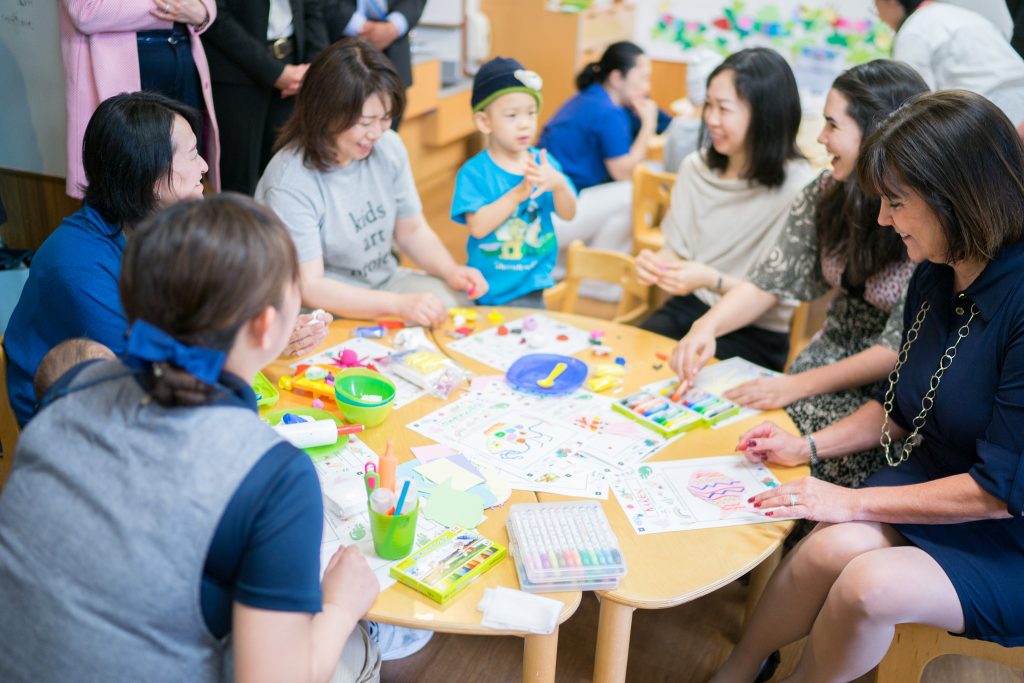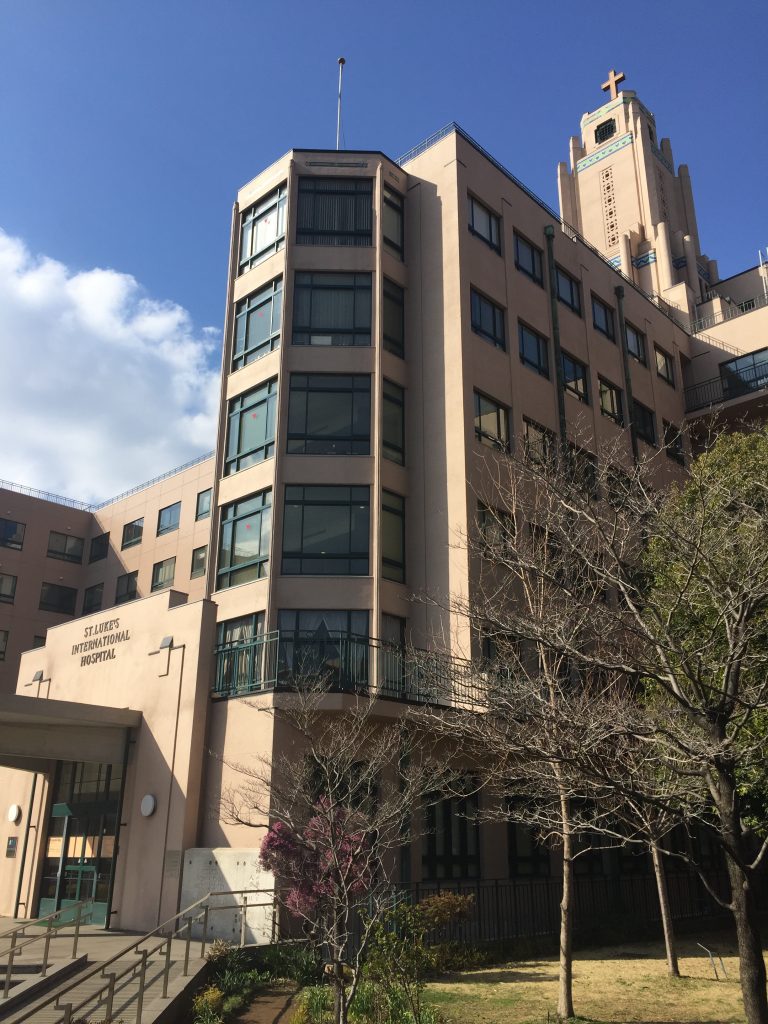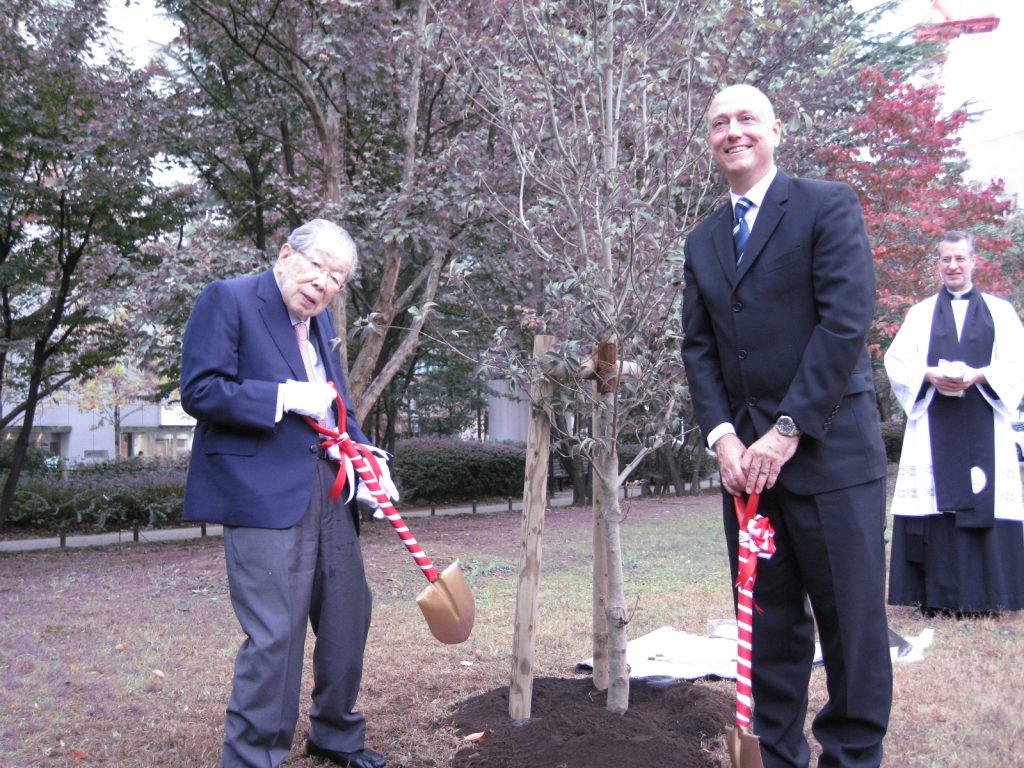St. Luke’s International Hospital has been a center of U.S.-Japan history for well over 100 years, making it an ideal venue for the Second Lady of the United States to highlight her commitment to advocating for art therapy as a beneficial intervention for patients with a wide range of health issues.
Vice President Mike Pence’s wife Karen and daughter Audrey paid a visit to the hospital on April 18, 2017, when they accompanied him on his first trip to Japan as vice president. At the hospital they observed an art therapy session in the pediatric ward and drew pictures of sea creatures with young patients. These drawings were later scanned, digitally animated, and projected into a digital aquarium on the wall where all the creatures swam together. Mrs. Pence also participated in a roundtable discussion with university professors, doctors, and other experts who are involved in art therapy in Japan.

Vice President Mike Pence's wife Karen participates in an art therapy session at St. Luke's International Hospital in Tokyo on April 18, 2017.
Many people in Japan may be aware that St. Luke's International Hospital is one of Tokyo's largest and most comprehensive medical care facilities. But what led to Mrs. Pence visiting this hospital in particular and what makes it such an important symbol of U.S.-Japan ties?
St. Luke’s was founded in 1901 by Dr. Rudolf Bolling Teusler, a 25 year-old missionary doctor from Georgia who was sent to Japan by the American Episcopalian Church. From its humble beginnings as an almshouse, the hospital initially consisted of a modest wooden-framed structure built on the edge of the foreign settlement in Tsukiji. From its inception, the hospital was geared toward elevating awareness of public health and providing child welfare and preventative medicine services, while at the same time offering high-quality nursing and medical care to a wide range of Tokyo residents.
The hospital was practically destroyed in the Great Kanto Earthquake of 1923. As fundraising had already begun in the United States for new hospital buildings designed by architect Antonin Raymond, who also designed the residence of the U.S. Ambassador to Japan, Dr. Teusler was able to rapidly rebuild. In 1927, St. Luke's College of Nursing became the first college of nursing to be established in Japan.
The hospital was able to remain open and continued its work throughout World War II. At the end of the war, the medical center was requisitioned by the United States Army for 11 years. St. Luke's continued to provide medical services to the Japanese community from barracks rented from the city of Tokyo throughout the postwar years of occupation.
One American missionary who was particularly active in helping Dr. Teusler raise funds for the expansion of the hospital was Dr. Paul Rusch, who spent over half a century developing youth education and rural agriculture in Yamanashi and is said to have introduced American football to Japan. His contributions are celebrated annually at the Paul Rusch Festival in Yatsugatake.
Although St. Luke’s International Hospital’s buildings and facilities have been expanded and upgraded over the years, they are still located in the same place as the original hospital. The original hospital building, with its iconic cathedral located inside, has withstood numerous temblors and remains open for visitors. One of the reasons the U.S. Embassy has a special connection with St. Luke’s is that the United States Legation was once situated in the spot where the hospital stands today. When the legation was relocated to Akasaka in 1890, eight stone tablets bearing stars, eagles, and shields, were left at Tsukiji to show that it once stood there. Three of these tablets were presented to the U.S. Embassy in a ceremony in 1984 and the remaining five stone tablets are still displayed on the hospital grounds.
Another important figure who was instrumental in transforming St. Luke’s into the highly respected institution it is today is Dr. Shigeaki Hinohara. The venerable physician, who was one of the longest-serving doctors in the world when he died in 2017 at age 105, began practicing medicine at St. Luke’s International Hospital and teaching at St. Luke’s College of Nursing in 1941. Dr. Hinohara’s father went to the United States in 1900 to study at Duke University in North Carolina, and Dr. Hinohara followed in his footsteps by studying at Emory University in Atlanta when he was 40 years old. As director of the hospital, Dr. Hinohara took an active role in the hospital’s development and expansion after World War II, and served as the chairman of the board of trustees until 2015. St. Luke’s was completely rebuilt in May 1992 with leading-edge capabilities aimed at patient-centered medicine for the 21st century. Under Dr. Hinohara’s guidance, the hospital established Japan’s first Department of Palliative Care Medicine and first Department of Psychosocial Medicine, as well as the first U.S.-style residency training program for young doctors. In 2017, Japan’s first English-based Graduate School of Public Health was established.
In 2015, Dr. Hinohara participated in a tree-planting ceremony at which the U.S. Embassy presented the hospital with two dogwood trees as part of the Friendship Blossoms Initiative to commemorate the 100th anniversary of Japan's gift of 3,000 cherry trees to Washington, D.C. The dogwood trees, which are thriving and blossoming on the hospital premises today, are a meaningful symbol of the lasting bonds of friendship not just between St. Luke’s International Hospital and the U.S. Embassy, but also between the United States and Japan.









COMMENTS4
聖路加国際病院はトイスラー博士と米国民による日本への永遠の貢ぎ物でした。戦前は貧しい人々には医療費が減免されていました。金持ちのための病院ではなかったのです。しかも、トイスラー博士の最終目標は日本に留まらず、中国、インド、中東のベイルートへと聖路加の医療・保健衛生のチェーンを広げることにありました。日本国民が豊かになれば、米国民とともにアジアの医療改革に貢献することまで構想していました。単なる日米友好ではない、忘れてはならない重要な遺言でした。
There are some interesting points in time in this article. There is some validity but I will take hold opinion until I look into it further. Good article, thanks and I want more! Added to my Feed as well.
聖路加国際病院は1902年ではなく1901年設立です。
私も家族全員で長年お世話になっている病院です。チャペルが荘厳で美しく、受診するたびに見に行っていましたが、今は修復のため入れず少し寂しいです。
私の母(80代)は聖路加で学んでいますが、当時はシスターが寮の部屋を抜き打ちチェックしていたとかで、本一冊向きが逆だったりすると注意をされたそうです:)
ハナミズキ(Dog Wood)は、昔、キリストが十字架にかけられた時に、一緒に悲しんだと聞いたことがあります。よってキリストの受難のシンボルでもあるそうですね。
LEAVE A COMMENT
TOP